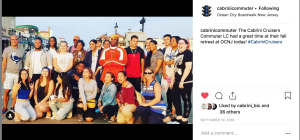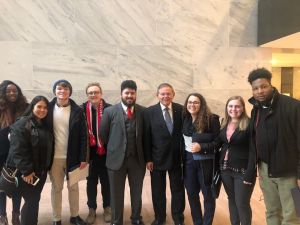College is meant to improve a student’s chances to find a career path and career that will make them both happy and money. This also means that colleges and universities need to keep themselves relevant and competitive in the higher education market.
Additionally, schools often have to adopt practices that try to make them unique or stand out to prospective students. One of these practices is called “High Impact” education. According to the Journal of Higher Education, high impact educational practices are meant to improve learning in college and university students and increase graduation rates.
This includes different classes and programs that allow for students learn at a higher or more intense level with the result that student retention and student engagement are increased.
Many colleges and universities have implemented such practices, including Cabrini University. Cabrini has put in place different programs to keep students engaged and to keep a high retention rate; including living, learning communities (LLC), engagement of the common good (ECG) classes, college success courses and senior capstone courses and projects.
Although these practices seem to have positive attributes and are intended to do well, and have done well at certain institutions like Cabrini, it may not be as successful needed or successful as some would like.
Living, Learning Communities & first year experience

The living, learning community program is made up of classes and professors dedicated to a theme or subject that creates a common environment for first-year students to learn about that topic while living in a residence hall together, most commonly as roommates and sharing the same halls.
Along with specific professors to help these first year students there is also a student-to-student option that is called the student fellow. It is a paid position for a student whom has gone through the program previously and lives with community in order to help guide and mentor the current students.
“The learning community shows in the literature that learning communities, just like all the high impact practices on retention and student progress,” Richie Gebauer, director of the Living Learning Community program, said.
The idea is to foster tight-knit friendships while growing in the specific topic they are all interested. Some of these communities include the Voices of Justice LLC, the Honors LLC, the Leadership LLC, Body Language LLC. There is even one for commuter students, so they can feel more connected to life on campus, called the Cabrini Cruisers.
The communities do different group trips and activities both inside and outside of the classroom such as going to Ocean City, New Jersey to do team bonding activities, visit a museum and share meals together that all tie back into the curriculum and Cabrini mission.
The Honors community lives on the fourth floor of East Residence hall, a freshman dorm on campus. the community has their own study lounge that can be used for social gatherings as well as studying together. The students in the hall take classes together and comprise of freshman that are from different backgrounds and majors.
“I like it. It lets me get to know actual people instead of just co-existing in classes together,” Allison Wojton, freshman honors student, said. “It’s more like high school in the sense that you know who’s in your area.”
The Cabrini Cruisers are for the commuting students and is different than the residential communities, as it is a different college experience. The Cruisers community is a group that comes together to learn how they fit into the larger Cabrini community and have coming of age-type of experience and bond with other students.
“To have the students in the LC overcome the challenges of commuting, learn how to be engaged commuter students, and realize their places at Cabrini and within leadership roles across campus.” Dr. Amber LaJeunesse, director of Student Engagement and Leadership and The Cabrini Cruisers, said. “This spring, we kicked off the semester with a family dinner at Bertucci’s to bring them back together as a community.”
For first-year students, there is also a required course called “college success.” This course is a pass/fail course that teaches students how to plan for their future and how to succeed in a college setting. The class engages its students by having discussions and writing reflection papers on what a student’s outlook for their freshman year and beyond is.
Engagement of the Common Good
High impact courses extend further than the first-year experience. Students at Cabrini are expected

to take three levels of engagement of the common good (ECG)classes. These classes are a requirement and are in place to do exactly what they are named – engage students in the common good.
There are different topics within the three levels such as food insecurity, immigration, addiction, housing, dating and domestic violence and prison. One class even goes to Guatemala every year during spring break. The classes allow students to learn about topics they are interested as well as hone their writing skills and be connected to the Cabrini message of social justice.
Senior Capstone
Cabrini has put in high impact practices that last through graduation. Senior capstone is a class that every senior goes through in order to graduate. It is a chance for students to show off what they have learned through their years of college. It is a final project of a topic that applies what has been learned and can be shown off to potential employers. It could be a research project, performance, a website or a portfolio of work.
Is it worth it?
There are many pros and cons to high impact practices. They can be expensive, not prove to have a higher retention rate and have a higher student failure rate. Colleges and universities can also be battling other issues that are unrelated to these programs and can be left with lower retention rates, therefore leaving them underfunded due to lake of tuition payments and other funding.
However, at Cabrini University the practices in place seem to be working, as Capstone projects are successful in launching and winning awards as well as those who participate Living, Learning Communities have a 10 percent higher retention rate than those who do not.
It helps with students learn how to be a part of a community and take action in causes they may not have previously and genuinely seems to help students grow in leadership skills and confidence.
“I have noticed that even the quiet students in the first year often grow to be engaged student leaders on this campus as upperclassmen. The first-year LC sets the tone and they continue to grow from it and past it,” LaJeunesse said. “A great example is our upcoming Orientation Coordinators [Francesca Maslin and Daisy Rodriguez] were both Cabrini Cruisers their first year at Cabrini.”
High impact practices, if implemented properly by an institution, will benefit students in the long run by allowing them to make connections with their peers, professors and other professionals both on and off campus.


